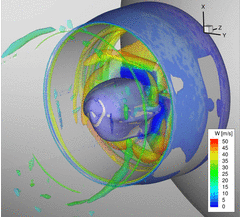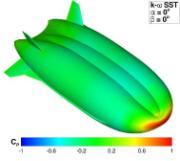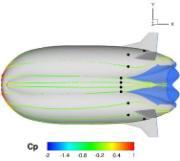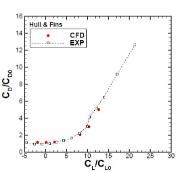CFD for Hybrid Air Vehicles
|
LOCATE (LOw CArbon aircraft using lighter than air TEchnology) is a collaborative project between Hybrid Air Vehicles Ltd, Blue Bear System Research, Forward Composites Ltd, University of Sheffield, Cranfield University and the University of Glasgow. Within the framework of the LOCATE project, University of Glasgow has the task of analysing lighter-than-air vehicles (LTAs) using Computational Fluid Dynamics (CFD). The focus is on the optimisation of the propulsors, and on the characterisation of the full vehicle aerodynamics. |
Propulsor Optimisation
A CFD model of the airship propulsors was developed to simulate the complex flow generated by the ducted propeller using the HMB3 flow solver. Fig. 1 shows the iso-surface of the Q-criterion, that allows to visualise the vortical flow behind the propeller blades, the engine nacelle and the cooling devices.
|
|
The optimisation of the propeller blade twist, and of the duct shape was also attempted, by coupling HMB3 with a gradient based optimiser. The optimisation framework uses an advanced adjoint solver (Biava et al. 2016) for the computation of the flow gradients needed by the optimiser. Current results show that the developed method is a viable tool for the efficient design of propulsors for LTAs (Biava and Barakos 2016).
Vehicle Aerodynamics
The aerodynamics of fully configured LTAs was analysed using the HMB3 flow solver. Simulations were carried out both at full scale and at model scale. Fig. 2, for instance, shows a view of the full-scale Airlander 50, coloured with pressure coefficient.
|
|
|
|
Fully turbulent simulations were performed first. Then, a transition model was employed to estimate the location of the transition onset. Fig. 3 shows the upper surface of the vehicle, including streamlines coloured with pressure coefficient and the transition onset points.
Wind tunnel data was available for a wind tunnel model of the Airlander 10, that allowed to assess the accuracy of the HMB3 method. A comparison between computed and measured loads on the Airlander 10 wind tunnel model is reported in Fig. 4, which shows the capability of the flow solver to accurately predict the aerodynamic loads.
Contacts
George Barakos George.Barakos@Glasgow.ac.uk
Massimo Biava Massimo.Biava@Glasgow.ac.uk
Marina Carrion Marina.Carrion@Glasgow.ac.uk
Publications
- Carrion, M., Steijl, R., Barakos, G. N., and Stewart, D. (2016) Analysis of lighter than air vehicles using computational fluid dynamics. Journal of Aircraft, (doi:10.2514/1.C033402) (Early Online Publication)
- Carrion, M., Biava, M., Steijl, R, Barakos, G. N. and Stewart, D., CFD Challenges for Hybrid Air Vehicle Applications, EUCASS Progress in Flight Physics, January 2016.
- Carrion, M., Biava, M., Steijl, R.,Barakos, G. N. and Stewart, D., CFD Study of Hybrid Air Vehicles, 54th AIAA Aerospace Sciences Meeting, AIAA SciTech, San Diego, CA, January 2016 (AIAA 2016-0059).
- Carrion, M., Biava, M., Steijl, R., Barakos, G. N. and Stewart, D., Analysis of Hybrid Air Vehicles using Computational Fluid Dynamics, 6th European Conference for AeroSpace Sciences, June 29 - July 3 2015, Krakow, Poland.
- Biava, M., and Barakos, G. N. (2016) Optimisation of ducted propellers for hybrid air vehicles using high-fidelity CFD. Aeronautical Journal, (Accepted for Publication)
- Biava, M., Woodgate, M., and Barakos, G. N. (2016) Fully implicit discrete-adjoint methods for rotorcraft applications. AIAA Journal, 54(2), pp. 735-749. (doi:10.2514/1.J054006)
- Biava, M., Carrion, M., Barakos, G. N. and D. Stewart, Adjoint Based Optimisation of Ducted Propellers for Hybrid Air Vehicles, 54th AIAA Aerospace Sciences Meeting, AIAA SciTech, San Diego, CA, January 2016 (AIAA 2016-1784).
- Biava, M., Carrion, M., Steijl, R. and Barakos, G. N., Optimisation of Ducted Fans with CFD, 41st European Rotorcraft forum, September 1-4 2015, Munich, Germany.







